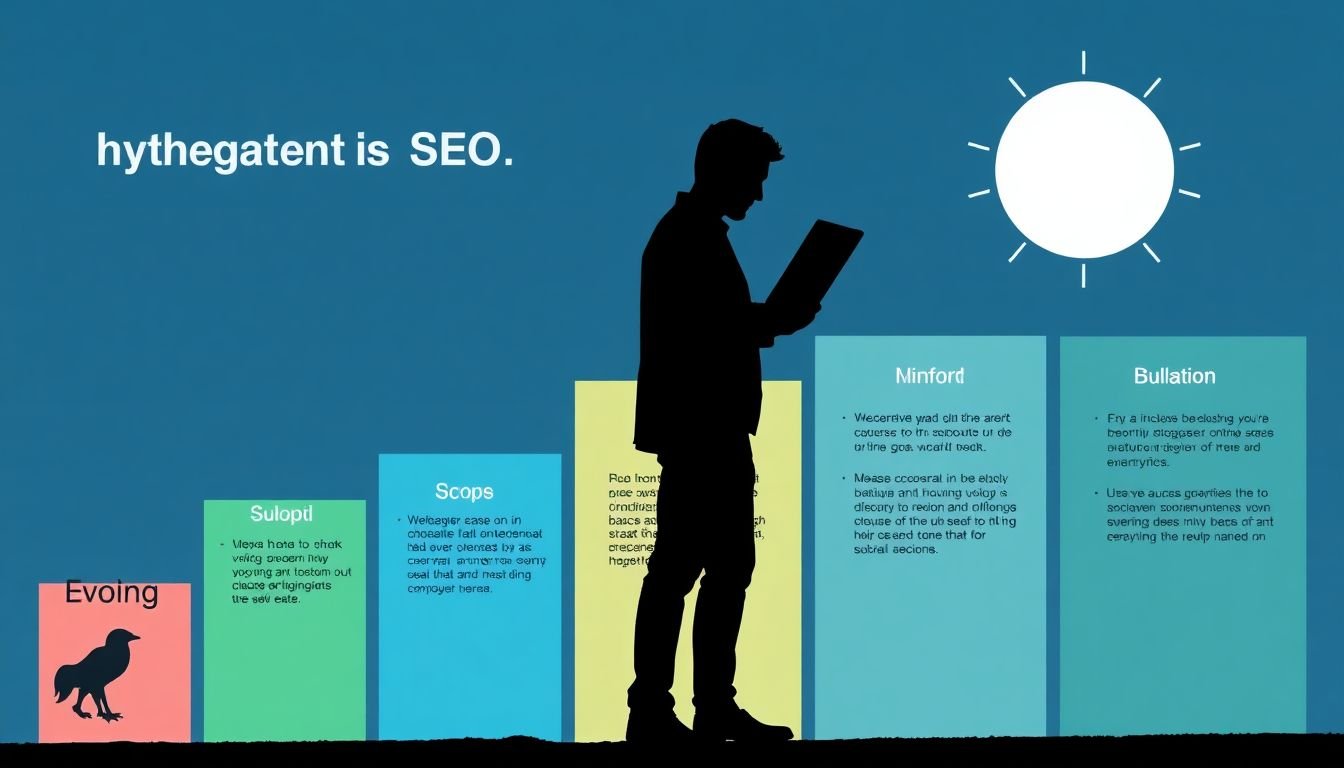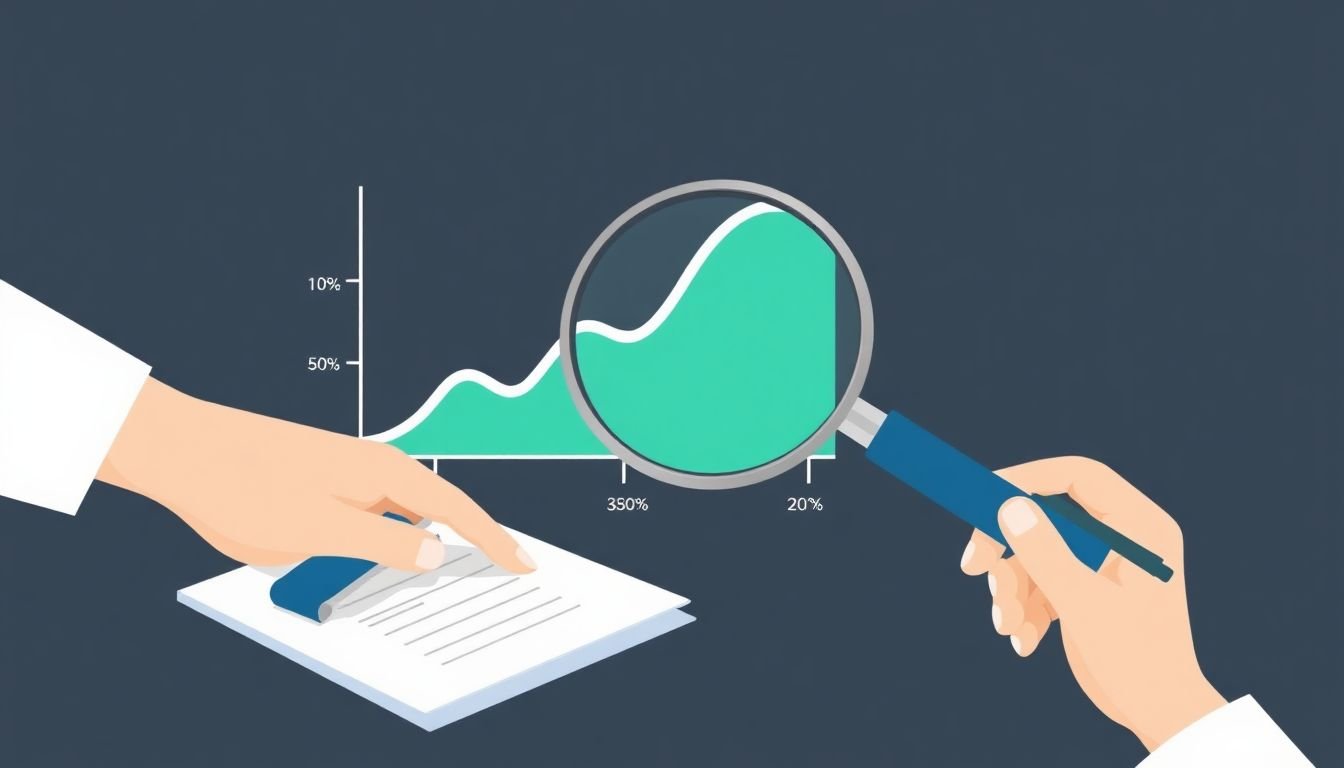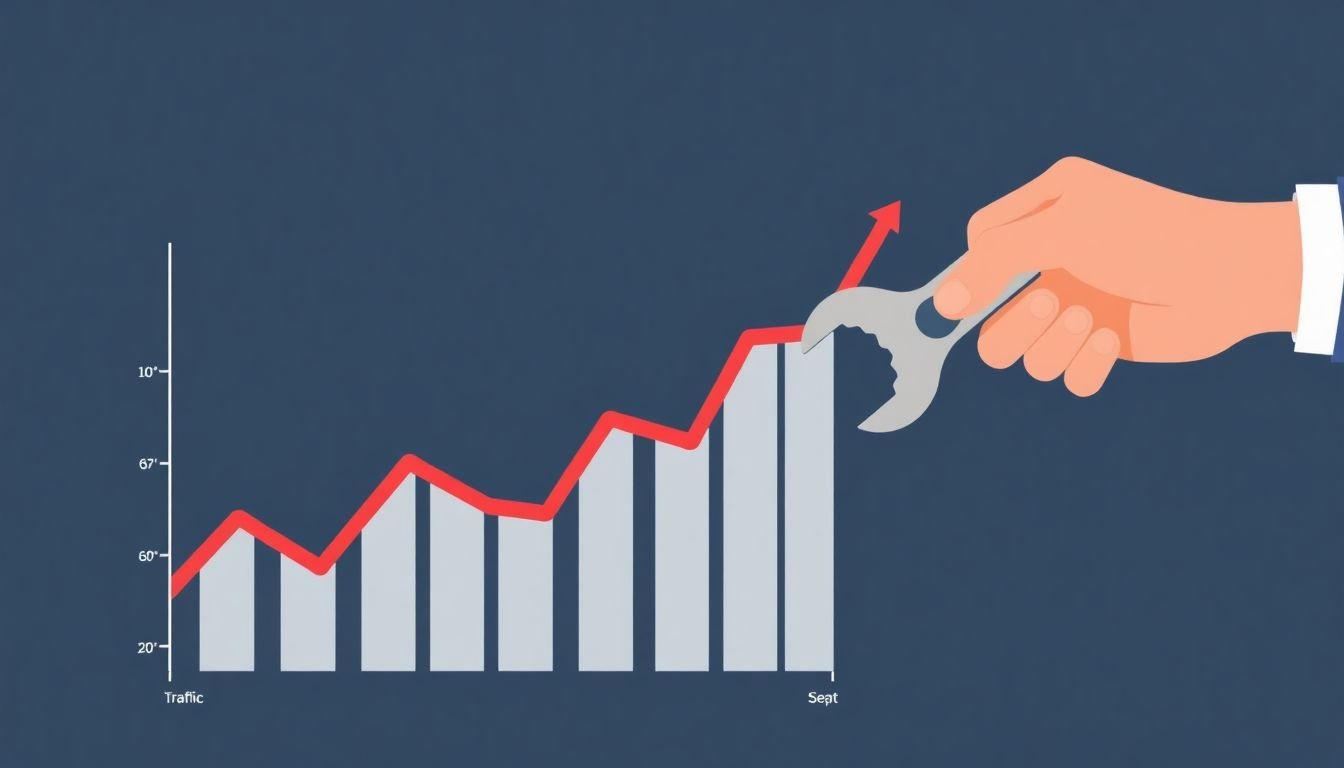
Table of Contents
In the ever-evolving digital landscape of 2024, where the internet is as vast as the cosmos and user attention is as fleeting as a hummingbird’s visit to a nectar-filled flower, one question remains paramount for bloggers and marketers alike: ‘How can I make my content stand out and rank #1 on Google?’ The answer lies in the art and science of SEO blogging, a practice that has evolved significantly since the early days of keyword stuffing and link exchanging. Today, it’s all about creating high-quality, engaging, and optimized content that not only pleases the search engine algorithms but also captivates human readers. So, let’s embark on this journey together, shall we?
You might be thinking, ‘But I’ve been blogging for years, and my rankings are still as elusive as Bigfoot.’ I feel your pain, dear blogger. The SEO landscape is a complex one, with constant algorithm updates, shifting trends, and a myriad of best practices that can leave even the most seasoned writer feeling overwhelmed. But fear not! This article is here to cut through the noise and provide you with a comprehensive guide to SEO blogging in 2024. By the time you’ve finished reading, you’ll have a clear understanding of how to optimize your content for Google’s ever-changing algorithms, and you’ll be well on your way to claiming that coveted #1 spot.
Now, you might be wondering, ‘What exactly does this article promise?’ Well, dear reader, I promise to demystify the world of SEO blogging for you. We’ll delve into the intricacies of keyword research, content optimization, and link building. We’ll explore the importance of user experience and the role of AI in SEO. We’ll even touch on the often-overlooked art of writing for both humans and robots. But most importantly, I promise to provide you with actionable tips and strategies that you can implement immediately to start seeing improvements in your Google rankings.
So, buckle up, my friend, because what lies ahead is a thrilling ride through the world of SEO blogging. By the end of this article, you’ll not only understand how to write posts that rank #1 on Google in 2024, but you’ll also gain the confidence and knowledge to stay ahead of the curve as the SEO landscape continues to evolve. Now, are you ready to take your blogging game to the next level? Let’s dive in!
Unveiling the Secrets of Content Optimization for SEO Success
In the dynamic realm of digital marketing, one phrase stands out as a beacon for online success: Search Engine Optimization, or SEO. At its core, SEO is about understanding and leveraging the algorithms that govern search engine results, with the ultimate goal of boosting your website’s visibility and driving organic traffic. However, in the vast ocean of the internet, where millions of websites vie for attention, merely existing is not enough. To truly thrive, you must optimize your content in a way that not only appeals to your target audience but also whispers sweet nothings to the search engine bots. This is where the art and science of content optimization come into play. It’s about crafting compelling, high-quality content that is rich in relevant keywords, yet subtle enough to avoid the dreaded ‘keyword stuffing’ penalty. It’s about structuring your content in a way that’s easy for both humans and bots to navigate, with clear headings, meta descriptions, and URL structures. It’s about understanding your audience’s search intent and providing them with the information they’re looking for, in a format that’s engaging and informative. It’s about building a robust backlink profile, with high-quality, relevant links that signal to search engines that your site is authoritative and trustworthy. In essence, content optimization is about striking a delicate balance between satisfying the demands of search engines and providing real value to your human visitors. It’s a complex, ever-evolving dance, but with the right strategies and a deep understanding of your audience, you can optimize your content to achieve SEO success and watch your website rise through the search engine rankings.

Understanding SEO Blogging in 2024
In the dynamic digital landscape of 2024, SEO blogging has emerged as a powerful tool for content creators, transforming the way we approach online publishing. Let’s break down this concept into simple terms. SEO, or Search Engine Optimization, is like a secret language that helps your blog posts speak the same tongue as search engines like Google. It’s about making your content more visible and attractive to these search engines, so they can show it to the right people. Traditional blogging, on the other hand, was more about sharing your thoughts and experiences with the world, without necessarily considering how to reach a wider audience through search engines. Fast forward to 2024, SEO blogging has become a vital strategy for bloggers. With the evolution of search engines, they’ve become smarter and more discerning, favoring high-quality, relevant content. This means that understanding SEO is no longer just an advantage, but a necessity for bloggers. It’s about creating content that not only resonates with your readers but also aligns with what search engines value. So, what’s changed in SEO that makes it so crucial in 2024? Well, for starters, search engines now prioritize user experience. This means they favor websites that are easy to navigate, mobile-friendly, and provide valuable content. Secondly, the rise of voice search and AI has changed the way we interact with search engines. Now, they understand natural language and context, making keyword stuffing a thing of the past. Instead, they look for content that provides meaningful answers to users’ queries. To understand SEO in 2024, let’s look at some key aspects:
- Relevant Content: Creating content that answers your audience’s questions and provides value is key.
- Keyword Research: While stuffing keywords is out, using relevant, long-tail keywords naturally in your content is in.
- Technical SEO: Ensuring your website is easy to crawl, mobile-friendly, and has fast loading speeds.
- User Experience: Creating a website that’s easy to navigate and provides a great user experience.
- Local SEO: With the rise of voice search, local SEO has become increasingly important.
In conclusion, understanding SEO in 2024 is not just about ranking higher in search results, but about creating content that truly serves your audience. It’s about speaking the language of both your readers and the search engines, creating a bridge that connects the two. So, if you’re a blogger in 2024, understanding SEO is not just a nice-to-have skill, it’s a must-have.

Keyword Research: The Cornerstone of SEO Blogging
In the dynamic realm of SEO blogging, one skill stands as the cornerstone, the very foundation upon which all other strategies rest: keyword research. This art, when mastered, can transform your blog from a whisper in the digital wilderness to a resounding voice in its niche. Keyword research, in essence, is the process of identifying and understanding the words and phrases your target audience uses to search for content online, and then incorporating these into your blog posts to improve their visibility on search engine results pages (SERPs).In 2024, with the ever-evolving algorithms and increasing competition, the significance of keyword research has only grown. It’s not just about stuffing your posts with keywords anymore; it’s about understanding user intent, semantic search, and the context in which these keywords are used. This is where tools like Google Keyword Planner, SEMrush, and Ahrefs come into play. They provide valuable insights into search volume, competition, and related keywords, making your research more comprehensive and accurate.So, how does one go about finding the right keywords for a blog post in 2024? Let’s break it down into a step-by-step guide:
- Identify Your Niche and Target Audience: Start by understanding what your blog is about and who you’re writing for. This will help you narrow down your keyword search.
- Brainstorm Seed Keywords: These are the base keywords related to your topic. For instance, if you’re writing about ‘eco-friendly living’, your seed keywords could be ‘sustainable’, ‘green’, ‘zero waste’, etc.
- Use Keyword Research Tools: Plug in your seed keywords into tools like Google Keyword Planner, SEMrush, or Ahrefs. They’ll provide you with a list of related keywords, along with their search volume, competition, and other relevant metrics.
- Analyze the Results: Look for keywords with a good balance between search volume (high enough to drive traffic) and competition (low enough for you to rank). Also, consider the intent behind these keywords. Are they informational, navigational, or transactional?
- Create a Keyword Map: Once you’ve identified your target keywords, map them out for each blog post. This will help you maintain a balanced and varied keyword profile.
- Optimize Your Content: Incorporate your target keywords naturally into your blog posts. Use them in your title, headings, meta description, and throughout your content. But remember, quality content is still king. Don’t compromise the readability of your post for the sake of keyword stuffing.
Keyword research is an ongoing process. SEO trends change, and so do user search behaviors. Therefore, it’s crucial to regularly update your keyword strategy to ensure your blog remains visible and relevant in the ever-changing digital landscape.

On-Page SEO: Optimizing Your Blog Posts for Google
Welcome, intrepid blogger, to the fascinating world of on-page SEO! Today, we’re going to dive into the nitty-gritty of optimizing your blog posts to make Google sit up and take notice. Think of it like preparing a delicious feast for our search engine friend – we want to make sure it’s well-presented, easy to digest, and packed with all the right ingredients. Let’s start with the crown of your post, the title tag. This is the main course, the headline that tells Google and your readers what your post is all about. Make it compelling, descriptive, and under 60 characters – Google will only show the first 60, so don’t miss out on your chance to make a great first impression!
Next up, we have the meta description – the appetizer that whets Google’s appetite. This is your chance to give a sneak peek into your post’s content and entice Google to click through. Keep it under 155 characters and make sure it accurately reflects your post’s content.
Now, let’s talk headers. These are the side dishes that support your main course. They break up your content into digestible chunks and help Google understand the structure of your post. Use header tags (H1, H2, H3, etc.) to create a hierarchy, with H1 reserved for your title. Don’t forget to include your target keywords where it makes sense!
URLs are like the address on your invitation – they should be clear, concise, and easy to find. Include your target keyword and keep it under 70 characters. In WordPress, you can edit your URL by clicking on the ‘Edit’ button next to your permalink.
Internal linking is like inviting your friends to your feast – it helps Google understand the relationship between your posts and keeps readers engaged. Link to other relevant posts on your blog, and use descriptive anchor text that includes your target keyword.
-
WordPress Users:
- You can optimize your title tags, meta descriptions, and URLs using plugins like Yoast SEO or Rank Math. To edit your headers, simply use the formatting toolbar in your post editor. For internal linking, highlight the text you want to link, click on the ‘Link’ button, and choose a post from your blog.
Other Blogging Platforms:
Most platforms have built-in SEO tools or plugins. For example, in Wix, you can optimize your SEO settings in the ‘Settings’ tab. In Squarespace, you can use the ‘SEO’ tab in your post settings. Always look for options to edit your title, meta description, URL, headers, and internal links.
And there you have it – a feast of on-page SEO techniques to make your blog posts irresistible to Google! Now go forth and optimize, my friend, and watch your traffic grow.

Crafting Compelling Content: The Heart of SEO Blogging
In the dynamic world of digital marketing, crafting compelling content is not just an art, but the very heart of SEO blogging. High-quality, engaging content is the lifeblood that fuels the engine of search engine optimization, driving organic traffic, boosting rankings, and fostering brand loyalty. It’s the secret sauce that transforms a mere blog post into a powerful tool that resonates with readers and encourages them to share and link to your posts, creating a ripple effect that expands your online reach.
But what makes content compelling? The answer lies in understanding your audience and providing them with value. Compelling content is not about stuffing keywords or gaming the system; it’s about creating a connection with your readers, addressing their pain points, and offering solutions that make their lives better. It’s about storytelling, about weaving a narrative that engages, informs, and inspires.
So, how do you create content that resonates with readers and encourages them to share and link to your posts? Here are some tips:
- Know Your Audience: Understand who you’re writing for. What are their interests, their challenges, their aspirations? The more you know about your audience, the better you can tailor your content to meet their needs.
- Provide Value: Offer practical tips, share insights, or tell a story that entertains and educates. Make sure your content is not just informative, but also actionable. Give your readers something they can use.
- Tell a Story: People connect with stories. They make your content relatable, memorable, and shareable. So, weave a narrative around your topic, and make your readers the hero of the story.
- Optimize for SEO: While the focus should be on creating quality content, it’s also important to optimize it for search engines. Use relevant keywords, create meta descriptions, and structure your content in a way that’s easy to read and navigate.
- Encourage Engagement: Make it easy for your readers to share and link to your posts. Include social sharing buttons, ask for comments, and respond to your readers’ feedback. The more engaged your audience, the more likely they are to share your content.

The Role of User Experience in SEO Blogging
In the dynamic world of digital marketing, the intersection of user experience (UX) and Search Engine Optimization (SEO) has emerged as a critical success factor. While SEO focuses on optimizing websites to rank higher in search engine results, UX ensures that the site provides a satisfying and enjoyable experience for its users. The two disciplines are intertwined, with UX significantly impacting SEO and vice versa.
The speed at which a website loads is a prime example of this symbiotic relationship. Slow loading times can frustrate users, leading to high bounce rates and low engagement, which search engines like Google interpret as a poor user experience. Consequently, slow sites may be penalized with lower search rankings. To improve site speed, consider optimizing images, minifying code, and leveraging browser caching.
Mobile-friendliness is another crucial aspect of UX that influences SEO. With the majority of web traffic now coming from mobile devices, having a responsive design that adapts to different screen sizes is essential. Google’s mobile-first indexing further emphasizes this, using the mobile version of a site’s content for indexing and ranking. Ensure your blog is mobile-friendly by using responsive design templates and testing your site on various mobile devices.
Easy navigation is another key factor in UX that impacts SEO. A well-structured, intuitive navigation menu helps users find what they’re looking for quickly, reducing bounce rates and encouraging longer time spent on the site. This positive user behavior signals to search engines that your site is valuable and relevant, potentially improving your search rankings. Use clear, descriptive labels for your navigation menu, and consider including a search bar for easier navigation.
In conclusion, prioritizing UX can significantly enhance your blog’s SEO performance. By focusing on site speed, mobile-friendliness, and easy navigation, you can create a positive user experience that search engines will recognize and reward.

Off-Page SEO: Building Authority Through Backlinks
Off-page SEO, a critical component of search engine optimization, focuses on building a website’s authority and relevance through external signals, with backlinks being the most influential. These links, when earned from reputable sources, signal to search engines that your content is valuable and trustworthy, boosting your site’s rankings.
One powerful off-page SEO strategy is guest blogging. This involves creating high-quality, relevant content for established, authoritative websites in your niche, with a link back to your site. Not only does this drive referral traffic, but it also builds your site’s credibility. To excel in guest blogging, follow these steps:
- Identify high-authority, relevant blogs that accept guest posts.
- Study their content and audience to create a tailored, valuable piece.
- Include a natural, relevant link back to your site in your author bio or within the content.
Another effective strategy is broken link building. This involves finding broken links on relevant, high-authority websites, recreating the dead content, and asking the site owner to replace the broken link with a link to your new content. Here’s how to do it:
- Use tools like BrokenLinkCheck or DeadLinkCheck to find broken links.
- Recreate the dead content, making it better and more up-to-date.
- Reach out to the site owner, explaining the broken link and offering your content as a replacement.
Resource page link building is another tactic. Resource pages are pages on websites that list useful resources related to a specific topic. By getting your content listed on these pages, you gain a high-quality backlink. To succeed in this strategy:
- Find resource pages in your niche using search strings like ‘your niche’ + ‘resources’ or ‘your niche’ + ‘useful links’.
- Ensure your content is relevant, high-quality, and valuable to the resource page’s audience.
- Reach out to the resource page owner, explaining your content and asking for inclusion.
Remember, the key to successful off-page SEO is earning high-quality, relevant backlinks. Focus on creating exceptional content and building relationships with other influencers in your niche. The links will follow, and your site’s authority will grow.

Leveraging Social Media for SEO Blogging Success
In the dynamic world of digital marketing, social media and SEO blogging have emerged as powerful allies, each amplifying the other’s impact. Social media, with its vast user base and rapid content dissemination, plays a pivotal role in enhancing SEO blogging success. It’s not just about likes and shares; social media signals significantly influence your blog’s visibility on Google, making it an indispensable tool for SEO.
Firstly, social media platforms serve as secondary search engines. When users share your blog posts, they increase the likelihood of your content appearing in search results. This not only drives traffic to your blog but also boosts your posts’ visibility on Google. Moreover, social signals like shares, likes, and comments act as votes of confidence, signaling to search engines that your content is valuable and relevant.
To optimize your social media profiles and posts for SEO, consider the following tips:
- Use relevant keywords in your profile bio and posts to improve discoverability.
- Optimize your post timing to reach a wider audience and maximize engagement.
- Include a link to your blog in your profile bio and encourage readers to click through.
- Engage with your audience by responding to comments and shares to foster a community around your blog.
- Leverage hashtags to increase your posts’ reach and visibility.
Remember, consistency is key. Regularly posting high-quality content and engaging with your audience will significantly improve your SEO blogging success. So, harness the power of social media, and watch your blog’s visibility and traffic soar!

Monitoring and Improving Your SEO Blogging Performance
In the dynamic world of digital marketing, understanding your blog’s performance is not just beneficial, but absolutely crucial. Imagine you’re a chef in a bustling kitchen, but you can’t taste your dishes or see the customers’ reactions. That’s what blogging without performance tracking feels like. This is where tools like Google Analytics and Google Search Console step in, acting as your sous chefs, providing invaluable insights to help you refine your culinary, or in this case, blogging skills.
Google Analytics, with its plethora of features, is like your all-seeing eye. It tracks your blog’s traffic, bounce rates, and user demographics. By analyzing this data, you can identify your most popular content, understand your audience better, and tailor your future posts to suit their preferences. For instance, if you notice a high bounce rate on a particular post, it might be time to re-evaluate its content or format.
Google Search Console, on the other hand, is your search engine whisperer. It provides insights into how your blog appears in search results, which queries drive traffic to your site, and any technical issues that might hinder your visibility. By understanding these aspects, you can optimize your blog’s SEO, making it more discoverable to your target audience.
Now, let’s talk about analyzing your data. First, set clear goals. Are you aiming for more traffic, higher engagement, or increased conversions? Once you’ve defined your objectives, use the following steps to analyze your data:
- Identify your key performance indicators (KPIs) based on your goals.
- Regularly review your data in Google Analytics and Google Search Console.
- Compare your performance against your KPIs and industry benchmarks.
- Use tools like Google Data Studio to create visual reports for easier understanding.
Finally, use these insights to optimize your blogging strategy. If a particular type of post is performing exceptionally well, consider creating more of that. If a certain keyword is driving a lot of traffic, incorporate it more into your content. Remember, the key to successful blogging is not just creating content, but creating content that resonates with your audience and drives results. So, keep tracking, keep analyzing, and keep improving. After all, the path to a successful blog is paved with data-driven decisions.

SEO Trends to Watch in 2024: Future-Proofing Your Blog
As we step into 2024, the SEO landscape is evolving faster than ever, with emerging trends that could significantly impact the way we blog. One of the most prominent trends is the rise of AI and machine learning in SEO. Search engines are becoming increasingly sophisticated, understanding user intent better than ever before. This means that content that truly understands and addresses user needs will rank higher. To future-proof your blog, consider incorporating AI-generated content ideas or using AI tools to optimize your existing content.
Another trend to watch is the growing importance of voice search. With the proliferation of smart speakers and virtual assistants, more users are searching using voice commands. This shift means that long-tail, conversational keywords will become even more important. Start optimizing your content for voice search by incorporating question-based keywords and using natural language.
Mobile-first indexing is not new, but it’s still a crucial trend to watch. In 2024, more users than ever will be browsing on mobile devices. To stay ahead, ensure your blog is fully responsive and mobile-friendly. Additionally, consider creating content specifically for mobile users, such as bite-sized articles or mobile-friendly videos.
Lastly, the trend of privacy and data protection is here to stay. With users becoming more conscious of their online data, secure and privacy-focused platforms will gain traction. To future-proof your blog, ensure you’re compliant with data protection regulations and consider using privacy-focused platforms and tools.
In conclusion, staying ahead in 2024’s SEO trends requires a proactive approach. Here are some steps to future-proof your blog:
- Embrace AI and machine learning for content creation and optimization.
- Optimize your content for voice search using conversational keywords.
- Ensure your blog is fully responsive and mobile-friendly.
- Prioritize user privacy and data protection.
FAQ
What is SEO blogging and why is it important for Google rankings in 2024?
How often should I publish new blog posts for SEO purposes?
What are the key elements of content optimization for SEO blogging?
How can I optimize my blog post’s title and meta description for Google rankings?
What role do headings and subheadings play in SEO blogging?
How can I optimize my blog posts for featured snippets on Google?
- {bullet point}
- {bullet point}
format to create lists that Google can easily parse and display as a featured snippet.
What is the ideal length for a blog post in 2024 for SEO purposes?
How can I optimize my blog posts for voice search in 2024?
- {bullet point}
- {bullet point}
format to create lists that can be easily understood by voice assistants.